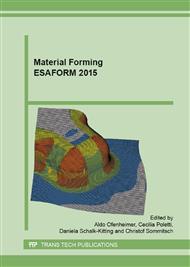p.102
p.108
p.114
p.120
p.126
p.132
p.138
p.144
p.150
Strain-Path Effects on the Formability Behavior of Interstitial-Free Steel
Abstract:
In this work, the formability behavior of Interstitial-Free (IF) steel sheet, grade DC07 with 0.65 mm of nominal thickness, was evaluated by means of both linear and bi-linear strain-paths to define the Forming Limit Curve (FLC) at the onset of necking according to ASTM E22182 standard. In the first strain-path, flat-bottomed punch with 200 mm diameter and 10 mm corner die radius was adopted together with counter-blanks of an IF steel sheet grade DC07 with 0.80 mm nominal thickness in order to yield two equal amounts of plastic work under uniaxial tension and under equibiaxial stretching strain-paths. Afterwards, Nakajima’s 100 mm hemispherical punch stretching procedure and bulge tests were adopted to determine the FLC of both as-received and strained DC07 blanks with the help of an automated digital image correlation system to define the linear and bi-linear limit strains. Increasing the straining level (5 and 10%) of the first strain-path in uniaxial tension improved the limit strains of the DC07 steel sheet between the plane-strain intercept (FLC0) and the biaxial stretching region of the FLC. On the other hand, blanks which were firstly pre-strained in equibiaxial stretching mode (4.8 and 9%) provided better formability in the FLC drawing region and reduced limit strains in plane-strain and biaxial stretching regions.
Info:
Periodical:
Pages:
126-131
Citation:
Online since:
July 2015
Price:
Сopyright:
© 2015 Trans Tech Publications Ltd. All Rights Reserved
Share:
Citation:


